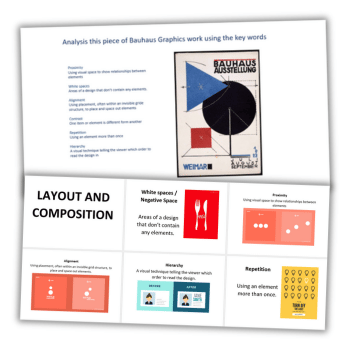Word docs, PowerPoint, PSD files
KS3, KS4
Years 7-11
The applied arts warrant a place within the secondary curriculum, argues head of art, Hannah Day…
This download contains resources for a Bauhaus graphics project. There are class/homework activities, visual displays and evaluation questions.
This simple project teaches students the basics of Photoshop, before leading to their first graphic outcome.
Inspired by the Bauhaus school, students will learn how to use Photoshop to move, rotate, resize and duplicate objects. They will then add simple text before applying their design to a set of four postage stamps.
This process teaches them about various design parameters, including dimensions, considerations around displaying the price and King’s head, and the need for a collection of different designs to convey a degree of unity.
With the added contextual element, you could spend around 12 hours on this project. However, you can also streamline the process. It’s a neat and rewarding project for students to take part in.
Why teach applied arts?
It’s fair to say that many schools – limited by resources and student numbers – only offer traditional, fine art-focused courses.
Most art teachers I know are painters who mix their own practice with teaching. It logically follows that if your work is fine art, then that’s where your teaching will be more focused too.
How we can ensure teachers and students get to develop confidence in the important area of applied arts?
It may be that your applied art provision is already extensive. Conversely, you may have barely thought about it at all. Or if you have, you may have dismissed it as a ‘lesser’ form of creativity.
Wherever you fall on the spectrum, we need all art teachers to value applied approaches to creativity, so that they can craft well-considered projects for their students.
Graphics
Graphics is a very popular course at my college for several reasons – the chief one being that students can see how it clearly leads into various careers.
They also respond well to having to meet clear briefs that have listed outcomes. They can bring their own interests to bear on their studies by linking projects to the graphics outcomes required within various fields.
For many, the more typically conceptual and personal nature of fine art projects holds little appeal, but they still want to be creative. These pathways offer them just that.
Recommended applied arts resources
If you’re relatively new to all this, don’t be put off by the potentially time-consuming nature of resource preparation. There are a great many free resources out there, so use those instead.
Among my favourites are the videos found on the Mr E’s Art Club YouTube channel. Each video spotlights an individual graphic or photographic artist, and then shows you how to recreate their work digitally, step by step.
Since each tutorial has a related artist, there’s an easy contextual link to ensure assessment objectives are being meet.
What’s more, those steps are demonstrated using Photopea – an image editing application clearly modelled on Photoshop, but free to use and a great alternative if your school lacks an Adobe licence.
It’s browser-based, meaning students can access it outside of school, thus opening up your homework possibilities.
Alternatively, decide what you want to teach and find a video to match. When teaching technical elements, I’ll ensure that I have related videos for many of the lessons coming up, as backups for absent students and those keen to recap certain topics and processes.
Link to what students love
It seems that nearly everything we encounter and interact with nowadays includes some form of branding, visual identity or graphic design.
Let students decide what the focus of their projects should be, and then use this as a base to which you can link the teaching.
Our course covers logo and typography design, websites and packaging – all of which can be applied to any number of sectors.
Take an album, for example – there will be a logo indicating the record label, website and social media details for the musicians, the dimensions of surrounding packaging itself, the CD cover and the typography used across it all.
I ask students to pick any brand – a product, place, film, album, book or campaign they’re interested in. The only area we steer clear of is game design, since games already have such a clear visual element.
This is, of course, covered across the duration of a 2-year A Level course, and you don’t have to do it all. You could tackle just one area.
Decide if logos play to your strengths, or if typography is what excites you. That way, your students can gain insights into applied art while still leaving time for those fine art activities.
Consider other pathways
I’ve focused so far on graphics, as that’s what I teach, but ‘applied’ can refer to any outcome that has a commercial end product.
Could your students photograph the rehearsals for the school’s next big theatre production and design the program? Could they design sculptures for a shared space within the school grounds and create a maquette as their outcome?
You could try redesigning the art block with architectural drawings, or design the bedroom of your dreams, complete with mood boards, fabric samples and your own self-designed lamp.
One of our ex-students, who now works as an architect, visits us from time to time and sits in on lessons.
After recounting a potted history of his journey from this very college to his current career, he sets the students a design brief hinging on a specific problem at a certain location, and provides them with a map of the surrounding land and existing building(s).
Most recently, this activity concerned a football club that needed to rebuild its changing facilities. The brief presented a mix of limits and possibilities and challenged students to find a balance between the two.
For that lesson, the students were able to experience the type of work undertaken by practising architects and consider it as a possible career route.
Indeed, several students stayed after the session to grill him, keen as they were to find out more.
So whatever you do, don’t overlook this varied and exciting aspect of art education. It’s where many of our students will likely end up, should they choose to enter the world of creative work – so let’s show them how to get started.
Online inspiration
If you’re unsure where to start with teaching applied art, see if the following suggestions can get those creative juices flowing…
Photography
You can find plenty of visually inspiring feeds on Instagram – one I particularly love is @things_i_see_when_its_ quiet.
Get students to record their visual style – maybe it’s muted colours, geometric shapes, industrial locations – then respond to their work, presenting it in the same grid format.
Textile design
Instagram user @imakestagram‘s feed is full of crazy tutorials. Her original clothing garments are somewhat resource-heavy, but her accessories are made with everyday items and easy for students to recreate themselves.
Link to millenary, footwear or costume design to widen the contextual base.
Architecture
Tiny Houses serves up numerous examples of compact living. Use these as inspiration to get students designing their own living space with a series of limits. This links well to environmental, housing supply and cost concerns.
Hannah Day is head of art, media and film at Ludlow College.














